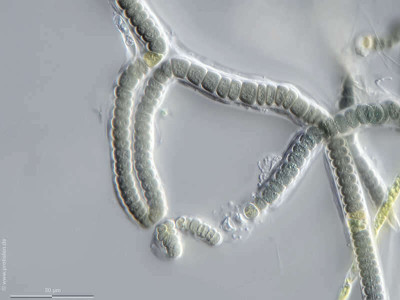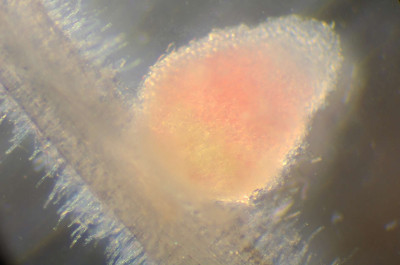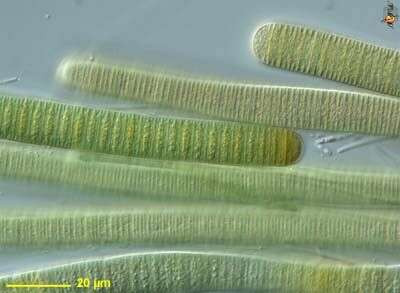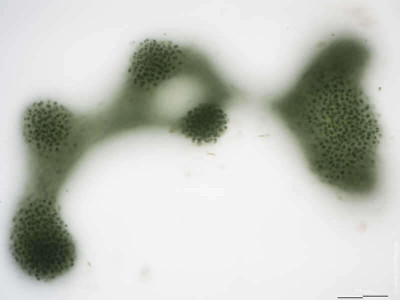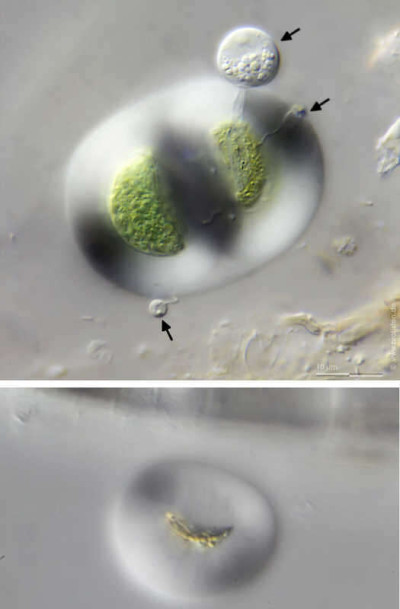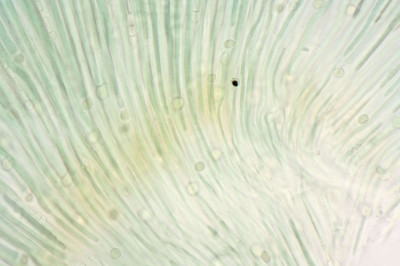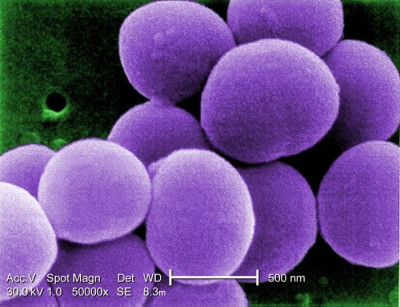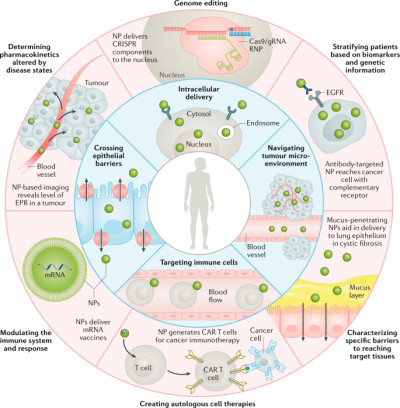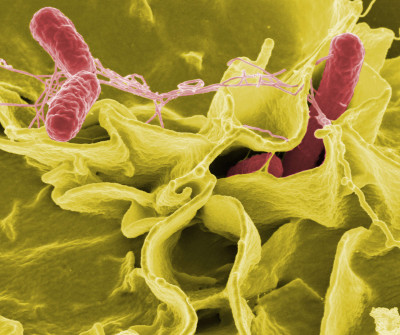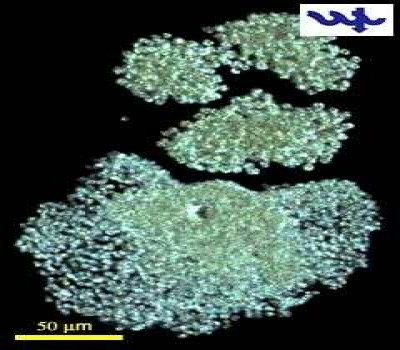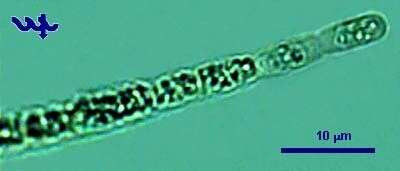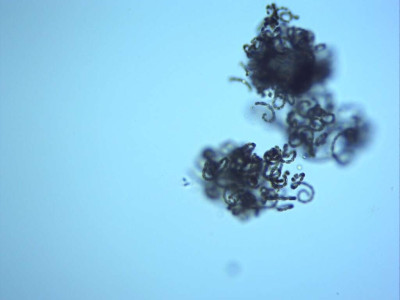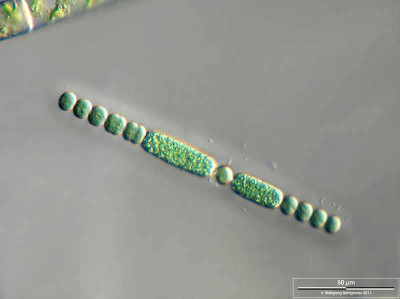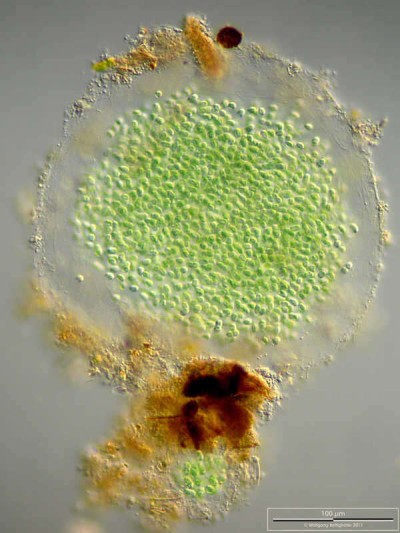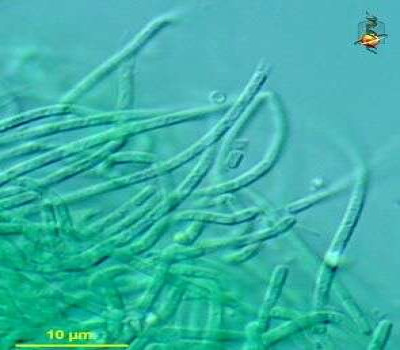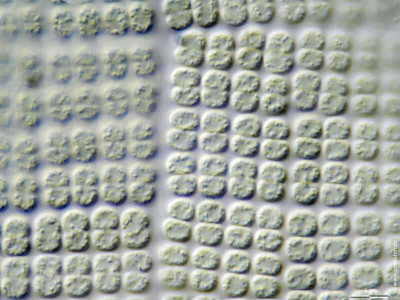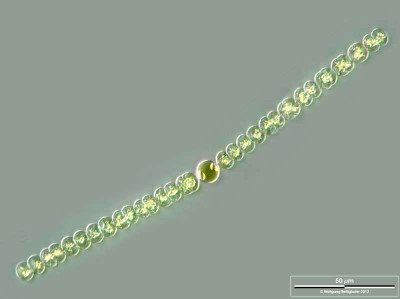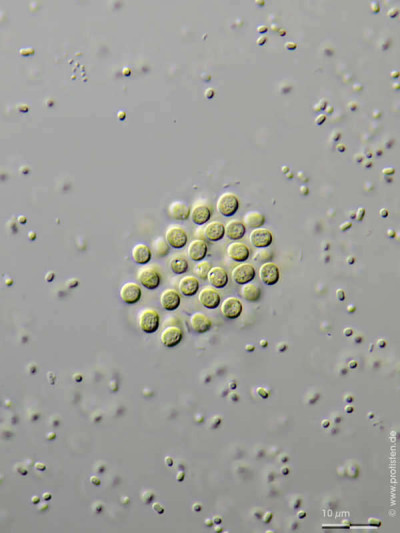Scale bar indicates 50 µm. The image was constructed using several photomicrographic frames with a manual stacking technique. Images were taken using a Zeiss Axioplan microscope with an Olympus OM-D E-M5 II MFT camera.
Wolfgang Bettighofer, protisten.de
01 Aug 2024
Anabaena is a genus of filamentous cyanobacteria known for its nitrogen-fixing capabilities and symbiotic relationships with various plants.
Sample from the pond Hegne Moor situated in the vicinity of Lake Constance. Images were taken using Zeiss Universal with Olympus C7070 CCD camera. Scale bar indicates 50 µm.
micro*scope
24 Jul 2024
Description: English: Closeup of a root nodule on a Medicago plant, inoculated with Sinorhizobium meliloti. The nodule has been cut in half and demonstrates the four zones of an indeterminate nodule. Date: 22 July 2009.
Ninjatacoshell, Wikimedia Commons
26 Jul 2024
Lyngbya, a filamentous blue-green alga (cyanobacterium), fairly substantial and usually found with a sheath around each filament. Differential interference contrast.
David Patterson, micro*scope
30 Jul 2024
Microcystis aeruginosa The scale bar indicates 100 µm. Collected from a pond near the Bodden bay Schwarzer Peter in the southern part of the isle Hiddensee (German Baltic Sea). This image was taken using Zeiss Axioplan with Olympus OM-D M5 MKII.
Wolfgang Bettighofer, protisten.de
01 Aug 2024
Chroococcus turgidus with chytrid parasite Chroococcus turgidus is attacked by Chytridiomycota cells. The arrows point to the three chytrid cells; the rhizoids they have drilled through the protective jelly to the host cell are clearly visible in the top two. The cell mass of the cyanobacteria is visibly reduced. In the image attached below, a sucked out Chroococcus cell. Scale bar indicates 10 µm. Sample from wetland of Lake Pillersee, St. Ulrich am Pillersee, Tyrol, Austria. Sampling date 06/2013. The image was built up using several photomicrographic frames with manual stacking technique. Images were taken using Zeiss Standard with Canon 600D.
Wolfgang Bettighofer, protisten.de
02 Aug 2024
Epiphytic on Lichina pygmaea, on rock on shore.
Malcolm Storey, BioImages, the virtual fieldguide, UK
05 Aug 2024
Under a very high magnification of 50,000x, this scanning electron micrograph (SEM) shows a strain of Staphylococcus aureus bacteria taken from a vancomycin intermediate resistant culture (VISA).
Under SEM, one can not tell the difference between bacteria that are susceptible, or multidrug resistant, but with transmission electron microscopy (TEM), VISA isolates exhibit a thickening in the cell wall that may attribute to their reduced susceptibility to vancomycin . See PHIL 11158 for a black and white version of this image. VISA and VRSA are specific types of antimicrobial-resistant staph bacteria. While most staph bacteria are susceptible to the antimicrobial agent vancomycin some have developed resistance. VISA and VRSA cannot be successfully treated with vancomycin because these organisms are no longer susceptible to vancomycin. However, to date, all VISA and VRSA isolates have been susceptible to other Food and Drug Administration (FDA) approved drugs.
Public Health Image Library
12 Aug 2024
Biological barriers to precision medicine applications significantly challenge its effectiveness. Genetic variability among individuals leads to differing responses to treatments, making it difficult to predict outcomes. Additionally, the complexity of diseases, especially those involving multiple genes and environmental factors, complicates the development of targeted therapies. Epigenetic modifications and gene-environment interactions further obscure the relationship between genotype and phenotype, limiting the precision of treatments. Moreover, the tumor microenvironment in cancer and the blood-brain barrier in neurological diseases pose significant obstacles to drug delivery. These barriers underscore the need for continued research and innovation to overcome the limitations of precision medicine.
26 Aug 2024
Description: Color-enhanced scanning electron micrograph showing Salmonella Typhimurium (red) invading cultured human cells Credit: Rocky Mountain Laboratories, NIAID, NIH All the images, except specified ones from the World Health Organization (WHO), are in the public domain. For the public domain images, there is no copyright, no permission required, and no charge for their use. Date: 10 November 2002 (according to Exif data). Source: NIAID: These high-resolution (300 dpi) images may be downloaded directly from this site.
NIAID: These high-resolution (300 dpi) images may be downloaded directly from this site, Wikimedia Commons
12 Oct 2024
Microcystis flos-aquae together with Microcystis aeruginosa is common in Lake Kinneret throughout the year, and blooming periodically. The cells at the border and at the center of Microcystis colony looks different by chlorophyll and gas vesicles concentrations. The specimen was sampled from the shore of the lake in March 2006.
Alla Alster; Tamar Zohary, micro*scope
22 Jul 2024
This photo shows the typical terminal cells of Aphanizomenon ovalisporum from Lake Kinneret. The filaments, 2 – 5 µm thick and 20 – 500 µm long, are terminated by an elongated hyaline cell, as seen in this picture.
Alla Alster,Tamar Zohary, micro*scope
22 Jul 2024
Dolichospermum lemmermannii, a filamentous cyanobacterium found in freshwater habitats, features long, unbranched filaments with cylindrical cells enveloped in a gelatinous sheath. Specialized heterocysts for nitrogen fixation are interspersed along the filament. Cells are typically 5-10 micrometers wide, and the organism is pigmented with chlorophyll a and phycobiliproteins, giving it a blue-green color. Reproduction occurs through filament fragmentation, aiding its spread in nutrient-rich waters. It plays a crucial ecological role in nutrient cycling but can form harmful algal blooms, impacting water quality in certain conditions.
townofbarnstable, iNaturalist
23 Jul 2024
Phase contrast image of unidentified Zetaproteobacteria that are marine Fe-oxidizers growing at the ends of iron-oxide filaments (cells denoted by arrows) from an in-situ incubation at Loihi (bar = 5 µm).
David Emerson, EOL staff
22 Jul 2024
Anabaena lapponica Scale bar indicates 50 µm. Sample from the pond Hegne Moor situated in the vicinity of Lake Constance. Images were taken using Zeiss Universal with Olympus C7070 CCD camera.Image under Creative Commons License V 3.0 (CC BY-NC-SA). Place name: Bog Hegne Moor near Lake Constance (Germany) Latitude: 47.718106 Longitude: 9.093974 Der Messbalken markiert eine Länge von 50 µm. Probe aus dem Simmelried nahe Konstanz. Mikrotechnik: Zeiss Universal, Kamera: Olympus C7070. Creative Commons License V 3.0 (CC BY-NC-SA). For permission to use of (high-resolution) images please contact postmaster@protisten.de.
Wolfgang Bettighofer, protisten.de
29 Jul 2024
Aphanothece stagnina Scale bar indicates 100 µm. Sample from the pond Hegne Moor situated in the vicinity of Lake Constance. Images were taken using Zeiss Universal with Olympus C7070 CCD camera.Image under Creative Commons License V 3.0 (CC BY-NC-SA). Place name: Bog Hegne Moor near Lake Constance (Germany) Latitude: 47.718106 Longitude: 9.093974 Der Messbalken markiert eine Länge von 100 µm. Probe aus dem Simmelried nahe Konstanz. Mikrotechnik: Zeiss Universal, Kamera: Olympus C7070. Creative Commons License V 3.0 (CC BY-NC-SA). For permission to use of (high-resolution) images please contact postmaster@protisten.de.
Wolfgang Bettighofer, protisten.de
29 Jul 2024
Phormidium (four-mid-ee-um) a filamentous blue-green alga with the filaments enclosed within an organic sheath. Differential interference microscopy.
David Patterson and Bob Andersen, micro*scope
29 Jul 2024
Merismopedia elegans Scale bar indicates 5 µm. Sample from the static fire tank of the village Kloster (Hiddensee Island). Sampling date 9/2022. Images were taken using Zeiss Universal with Olympus OM-D M5 MKII.
Wolfgang Bettighofer, protisten.de
30 Jul 2024
Dolichospermum sigmoideum Scale bar indicates 50 µm. Sample from a wetland at the Pillersee (Tyrol, Austria). The image was built up using several photomicrographic frames with manual stacking technique. Images were taken using Zeiss Universal with Canon EOS 600D.
Wolfgang Bettighofer, protisten.de
30 Jul 2024
Chroococcus dispersus Scale bar indicates 10 µm. Collected from a pond near Lemkendorf, isle of Fehmarn (Baltic Sea). The image was built up using several photomicrographic frames with manual stacking technique. The images were taken using Zeiss Axioplan with Canon EOS 70D.
Wolfgang Bettighofer, protisten.de
30 Jul 2024
 Encyclopedia
Encyclopedia
